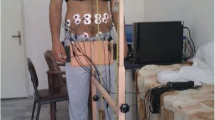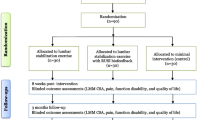Abstract
Background
In the literature and in clinical practice, reduced activity of the back muscles [multifidus] has been associated with low back pain. Multifidus exercise can reduce low back pain intensity and improve back muscle activity. In the past decade, several researchers assessed the effect of multifidus on back pain by assessing the pain and functional outcome. There are limited studies which assessed the muscle activity by electromyography [EMG].
Objective
This study aimed to quantify the efficacy of the spinal segmental stabilization [multifidus] exercise program in chronic low back pain and also to determine its efficacy to improve the muscle activity and reduction of pain.
Methods and main outcome
This was a pretest/posttest, single group experimental study with purposive sampling. Thirty patients (18 males and 12 females) with chronic (>3 months) low back pain were included for the study. All the subjects were screened with modified Hendler 10-min questionnaire for chronic back pain to rule out psychological pain and were assessed for instability with the multifidus test and segmental instability test, and those who showed positive results were selected for the study. The mechanical low back pain was quantified with surface EMG [maximal voluntary isometric contraction] and visual analogue scale [pain]. All the subjects were given spinal segmental stabilization [multifidus] exercises, twice a day for 6 weeks. They were reassessed with the same tools at the end of the study after 6 weeks of exercises. The statistical analysis was done by paired “t” test.
Results
The calculated t values (P < 0.05) for maximal voluntary isometric contraction of right and left multifidus muscles and pain perception in visual analogue scale were 45.69, 33.7, and 27.05, respectively. This shows that the calculated t value was higher than the table value of 2.045, and hence, the alternate hypothesis is accepted. Thus, the statistical analysis shows significant results in the reduction of mechanical low back pain by spinal segmental stabilization [multifidus] exercise program.
Conclusion
This study shows that exercise plays a vital role in alleviating low back pain—in particular the mechanical back pain due to spinal instability, which is in a great need of spinal segmental stabilization [multifidus] exercise program. The improvement in muscle activity and reduction of pain proven by the multifidus exercise program administered in this current study can be added for the management of mechanical low back pain in computer professionals.






Similar content being viewed by others
References
“Lower Back Pain Fact Sheet.nih.gov”. Retrieved 2008-06-16
www.irishhealth.com. Lumbago. Accessed 25 Dec 2009
Henschke N, Maher CG, Refshauge KM et al (2009) Prevalence of and screening for serious spinal pathology in patients presenting to primary care settings with acute low back pain. Arthritis Rheum 60(10):3072–3080
Skinner HB (2000) Lange current diagnosis & treatment in orthopedics (II ed.). McGraw Hill, New York, 5:195–196
Porter SB (2003) Tidy’s physiotherapy (XIII ed.). Butterworth-Heinemann, Edinburgh, 4:108–109
Heliovaara M (1989) Risk factors for low back pain and sciatica. Ann Med 21:257
van Tudler MW, Koes BW, Bouter LM (1995) A cost-of-illness study of back pain in The Netherlands. Pain 62:233–240
Brotzman SB, Wilk KE (2003) Clinical orthopaedic rehabilitation (II ed.). Mosby, Philadelphia 9:555–601
Schuldiner I (1998) The relationship between low back instability and low back pain. Article published in American Physical Therapy Association (APTA—Aug)
Panjabi MM (1992) The stabilizing system of the spine. Part I. Function, dysfunction, adaptation, and enhancement neutral zone and instability hypothesis. J Spinal Disord 5(4):383–389
Panjabi MM (1992) The stabilizing system of the spine. Part II. Neutral zone and instability hypothesis. J Spinal Disord 5(4):390–396
Richardson C, Jull G, Hodges P, Hides J (1999) Therapeutic exercise for spinal segmental stabilization in low back pain. Churchill Livingstone, Edinburgh
Hides JA, Richardson CA, Jull GA (1996) Multifidus muscle recovery is not automatic following resolution of acute first episode low back pain. Spine 21:2763–2769
Cole AJ, Herring SA (1997) Low back pain hand book, Ith edn. Jaypee, New Delhi
Johnson B (1970) The functions of individual muscles in the lumbar part of the spinae muscle. Electromyogr 10:5–21
Gromley J, Hussey J (1999) Exercise therapy prevention and treatment of disease (I ed). Blackwell, Oxford, 10:180–188
Hides JA, Stokes MJ, Saide M, Jull GA, Cooper DH (1994) Evidence of lumbar Multifidus muscle wasting ipsilateral to symptoms in patients with acute/subacute low back pain. Spine 19:165–172
Hides JA (2001) Proceedings of the First International Conference on Movement Dysfunction, Edinburgh
Waddell G, Newton M, Henderson I, Somerville D, Main CJ (1993) A fear—Avoidance Beliefs Questionnaire (FABQ) and the role of fear – avoidance beliefs in chronic low back pain and disability. Pain 52:157–168
Basmajian JV, Deluca CJ (1985) Muscles alive. Their functions revealed by electromyography. Williams and Wilkins, Baltimore
Wilke HJ, Wolf S, Claes LE, Arand M, Wiesend A (1995) Stability increase of the lumbar spine with different muscles groups. A biomechanical in vitro study. Spine 20:192–198
Hodges PW, Richardson CA (1999) Altered trunk muscle recruitment in people with low back pain with upper limb movement at different speeds. Arch Phys Med Rehabil 80(9):1005–1012
Hodges PW, Richardson CA (1999) Transversus abdominis and the superficial abdominal muscles are controlled independently in a postural task. Neurosci Lett 265(2):914
Macdonald DA, Moseley GL, Hodges PW (2006) The lumbar multifidus: does the evidence support clinical beliefs? Man Ther 11(4):254–263
Richardson CA, Jull GA, Hodges PW, Hides J (1999) Therapeutic exercise for spinal segmental stabilization in low back pain. Churchill Livingston, London
Foster NE, Thompson KA, Baxter GD (1999) Managementof nonspecific low back pain by physiotherapists in Britain and Ireland. Spine 24:1322–1342
Haij AJ, Moffroid M, Henry S (1991) A technique for needle localization in paraspinal muscles with cadaveric confirmation. Muscle Nerve 14:521–526
Richardson CA, Jull GA (1995) Muscle control pain. What exercise would you prescribe? Man Ther 1:1–10
Robinson R (1992) The new back school perception: stabilisation training part I. Occup Med 7:17–31
Norris CM. Spinal Stabilisation 5. An exercise programme to enhance lumbar stabilisation. Physiotherapy 81:138-45
Lindgren K-A, Sihvonen T, Leino E, Pitkanen M, Manninen H (1993) Exercise effects on functional radiographic findings and segmental Electromyographic activity in lumbar spine instability. Arch Phys Med Rehab 74:933–939
European guidelines for the management of acute nonspecific low back pain in primary care
Merskey H, Bogduk N (eds) (1994) Classification of chronic pain. Descriptions of chronic pain syndromes and definitions of pain terms, 2nd edn. IASP Press, Seattle
Magee DJ (2002) Orthopedic physical assessment, 4th edn. Saunders, New York, pp. 499, 500, and 524
Wadsworth CT, DeFabio RF, Johnson D (1988) The spine. In: Manual examination and treatment of the Spine and Extremities. Williams & Wilkins, Baltimore
Vasseljen O, Dahl HH, Mork PJ, TorpP HG (2006) Muscle activity onset in the lumbar multifidus muscle recorded simultaneously by ultrasound imaging and intramuscular electromyography. Clin Biomech 21:905–913
Hodges PW, Cresswell AG, Thorstensson A (2001) Perturbed arm movement cause short-latency postural responses in trunk muscles. Exp Brain Res 138:243–245
Danneels LA, Coorevits PL, Cools AM, Vanderstraeten GG, Cambier DC, Wityrouw EE, Cuyper HJ (2002) Differences in electromyographic activity in the multifi dus muscle and the iliocostalis lumborum between healthy subject and patients with sub-acute and chronic low back pain. Eur Spine J 11:13–19
Tong HC, Haig AJ, Yamakawa KS, Miner JA (2005) Paraspinal electromyography: age-correlated normative value in asymptomatic subjects. Spine 30:499–502
Arokoski JP, Kankaanpaa M, Valta T, Juvonen I, Partanen J, Taimela S, Lindgren KA, Airaksinen O (1999) Back and hip extensor muscle function during therapeutic exercises. Arch Phys Med Rehabil 80(7):842–850
Hermes HJ, Freriks B, Disselhorst-Klug C, Rau G (2000) Development of recommendation for SEMG sensor and sensor placement procedures. J Electromyogr Kinesiol 10:361–374
Jull GA, Richardson CA (1994) Rehabilitation of active stabilisation of the lumbar spine. In: Twomey LT, Taylor JR (eds) Physical Therapy of the Low Back, 2nd edn. Churchill Livingstone, New York, pp 251–273
Richardson CA, Jull GA (1994) Concepts of assessment and rehabilitation for active lumbar stability. In: Boyling JD, Palastanga N (eds) Grieve’s modern manual therapy, 2nd edn. Churchill Livingstone, Edinburgh, pp 705–720
Arokoski JP, VAlta T, Airaksinem O, Kankaanpaa M (2001) Back and abdominal muscle function during stabilization exercises. Arch Phys Med Rehabil 82(8):1089–1098
Mayer TG, Smith SS, Keeley J, Mooney V (1985) Quantification of lumbar function. Part – 2: sagital plane strength in low back pain patients. Spine 10:765–772
Cooper RG, StClair Forbes W, Jayson MIV (1992) Radiographic demonstration of paraspinal muscle wasting in patients with chronic low back pain. Br J Rheumatol 31:389–394
Grieve GP (1982) Lumbar instability. Physiotherapy 68:2–9
Frymoyer JW, Selby DK (1985) Segmental instability. Rationale for treatment. Spine 10:280–285
Panjabi M, Abumi K, Duranceau J, Oxland T (1989) Spinal stability and inter- segmental muscle forces. A biomechanical model. Spine 14:194–200
Kaigle AM, Holm SH, Hansson TH (1995) Experimental instability in the lumbar spine. Spine 20:421–430
Bigos S, Bowyer O, Braen G, et al. (1994): Acute low back problems in adults. AHCPR Publication 95-0642. Rockville, MD, Agency for health Care Policy and Research, Public Health Service, US Department of Health and Human Services
Kankaanpaa M, Taimela S, Airaksinen O et al (1999) The efficacy of active rehabilitation in chronic low back pain: effect on pain intensity, self-experienced disability, and lumbar fatigability. Spine 24:1034
O’Sullivan P, Twomey L, Allison G (1997) Evaluation of specific stabilisation exercise in the treatment of chronic low back pain with radiologic diagnosis of spondylolysis or Spondylolisthesis. Spine 24:2959–2967
Roy SH (1989) Lumbar muscle fatigue and chronic low back pain. Spine 14:992–1001
Biedermann HJ, Shanks GL, Inglis J (1990) Median frequency estimates of paraspinal muscles: reliability analysis. Electromyogr Clin Neurophysiol 30:83–88
Taimela S, Harkapaa K (1996) Strength, mobility, their changes, and pain reduction in active functional restoration for chronic low back pain disorders. J Spinal Disorders 9:306–312
Malcolm, Allan (1992) The lumbar spine and back pain. Churchill Livingstone, Edinburgh
Richardson CA, Jull G, Toppenberg R, Comerford M (1992) Techiniques for active lumbar stabilization for spinal protection: a pilot study. Aust J Phys Ther 38:105–112
Acknowledgments
Our sincere thanks to the Chairman, Director of Medical Education, Dr. Arun Vijay, principal, staffs, colleagues, and students especially Mr. Venkatesh, Mr. Sathish, and Mr. Saravanan of the KG College of Physiotherapy, Coimbatore. We also express our heartful gratitude to Mr. Shayam Sundar, KGiSL, and Ms. Jaseena, EMG Technician, KG Hospitals, Coimbatore.
Ethical approval
This study was approved by the ethical committee and the research department of the KG Institute of Health Sciences, KG Hospitals, and PG Research Institute, Coimbatore, India.
Conflict of interest
There is no conflict of interest and funding source for this research study.
Author information
Authors and Affiliations
Corresponding author
Rights and permissions
About this article
Cite this article
Leo Rathinaraj, A.S., Sreeja, M.T., Arun, B. et al. A surface electromyographic study to assess the effect of spinal segmental stabilization [multifidus] exercise program in chronic mechanical low back pain patients. Eur Orthop Traumatol 3, 161–168 (2012). https://doi.org/10.1007/s12570-012-0113-y
Received:
Accepted:
Published:
Issue Date:
DOI: https://doi.org/10.1007/s12570-012-0113-y




